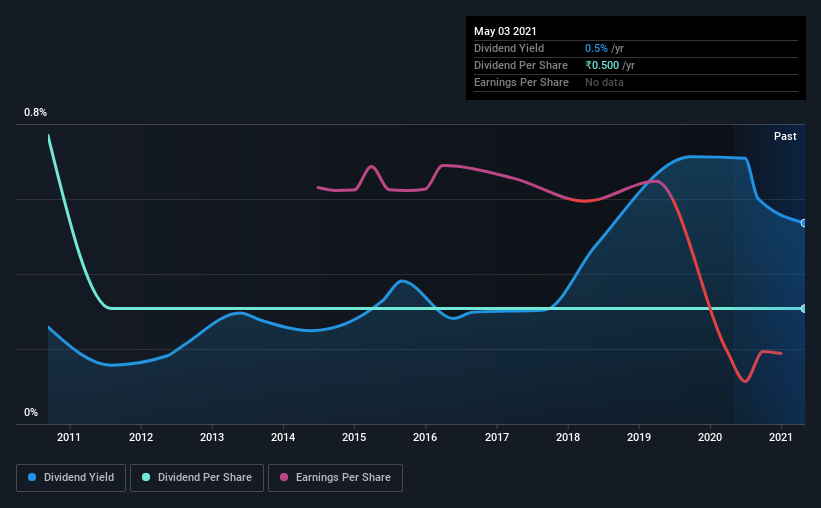- India
- /
- Energy Services
- /
- NSEI:JINDRILL
Should You Buy Jindal Drilling & Industries Limited (NSE:JINDRILL) For Its Dividend?
Today we'll take a closer look at Jindal Drilling & Industries Limited (NSE:JINDRILL) from a dividend investor's perspective. Owning a strong business and reinvesting the dividends is widely seen as an attractive way of growing your wealth. Yet sometimes, investors buy a popular dividend stock because of its yield, and then lose money if the company's dividend doesn't live up to expectations.
A 0.5% yield is nothing to get excited about, but investors probably think the long payment history suggests Jindal Drilling & Industries has some staying power. Some simple analysis can offer a lot of insights when buying a company for its dividend, and we'll go through this below.
Click the interactive chart for our full dividend analysis

Payout ratios
Companies (usually) pay dividends out of their earnings. If a company is paying more than it earns, the dividend might have to be cut. So we need to form a view on if a company's dividend is sustainable, relative to its net profit after tax. While Jindal Drilling & Industries pays a dividend, it reported a loss over the last year. When a company recently reported a loss, we should investigate if its cash flows covered the dividend.
Unfortunately, while Jindal Drilling & Industries pays a dividend, it also reported negative free cash flow last year. While there may be a good reason for this, it's not ideal from a dividend perspective.
Consider getting our latest analysis on Jindal Drilling & Industries' financial position here.
Dividend Volatility
Before buying a stock for its income, we want to see if the dividends have been stable in the past, and if the company has a track record of maintaining its dividend. Jindal Drilling & Industries has been paying dividends for a long time, but for the purpose of this analysis, we only examine the past 10 years of payments. The dividend has been cut on at least one occasion historically. During the past 10-year period, the first annual payment was ₹1.3 in 2011, compared to ₹0.5 last year. This works out to be a decline of approximately 8.8% per year over that time. Jindal Drilling & Industries' dividend has been cut sharply at least once, so it hasn't fallen by 8.8% every year, but this is a decent approximation of the long term change.
A shrinking dividend over a 10-year period is not ideal, and we'd be concerned about investing in a dividend stock that lacks a solid record of growing dividends per share.
Dividend Growth Potential
With a relatively unstable dividend, and a poor history of shrinking dividends, it's even more important to see if EPS are growing. Over the past five years, it looks as though Jindal Drilling & Industries' EPS have declined at around 52% a year. With this kind of significant decline, we always wonder what has changed in the business. Dividends are about stability, and Jindal Drilling & Industries' earnings per share, which support the dividend, have been anything but stable.
Conclusion
To summarise, shareholders should always check that Jindal Drilling & Industries' dividends are affordable, that its dividend payments are relatively stable, and that it has decent prospects for growing its earnings and dividend. It's a concern to see that the company paid a dividend despite reporting a loss, and the dividend was also not well covered by free cash flow. Earnings per share are down, and Jindal Drilling & Industries' dividend has been cut at least once in the past, which is disappointing. There are a few too many issues for us to get comfortable with Jindal Drilling & Industries from a dividend perspective. Businesses can change, but we would struggle to identify why an investor should rely on this stock for their income.
Investors generally tend to favour companies with a consistent, stable dividend policy as opposed to those operating an irregular one. However, there are other things to consider for investors when analysing stock performance. Just as an example, we've come accross 4 warning signs for Jindal Drilling & Industries you should be aware of, and 2 of them are a bit unpleasant.
Looking for more high-yielding dividend ideas? Try our curated list of dividend stocks with a yield above 3%.
If you’re looking to trade Jindal Drilling & Industries, open an account with the lowest-cost* platform trusted by professionals, Interactive Brokers. Their clients from over 200 countries and territories trade stocks, options, futures, forex, bonds and funds worldwide from a single integrated account. Promoted
New: Manage All Your Stock Portfolios in One Place
We've created the ultimate portfolio companion for stock investors, and it's free.
• Connect an unlimited number of Portfolios and see your total in one currency
• Be alerted to new Warning Signs or Risks via email or mobile
• Track the Fair Value of your stocks
This article by Simply Wall St is general in nature. It does not constitute a recommendation to buy or sell any stock, and does not take account of your objectives, or your financial situation. We aim to bring you long-term focused analysis driven by fundamental data. Note that our analysis may not factor in the latest price-sensitive company announcements or qualitative material. Simply Wall St has no position in any stocks mentioned.
*Interactive Brokers Rated Lowest Cost Broker by StockBrokers.com Annual Online Review 2020
Have feedback on this article? Concerned about the content? Get in touch with us directly. Alternatively, email editorial-team (at) simplywallst.com.
About NSEI:JINDRILL
Jindal Drilling & Industries
Engages in providing drilling and related services to the oil and gas exploration companies in India.
Flawless balance sheet with solid track record and pays a dividend.
Market Insights
Community Narratives




